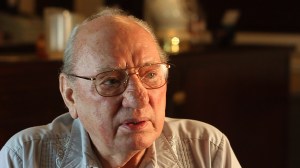
I taught my very first First Year Seminar at Loyola in the spring of 2010. My idea for the course was to have the students work in teams to produce a simple documentary film about some aspect of immigration and ethnicity in New Orleans. One of the student teams decided to focus on the Deutsches Haus in Mid-City, a place that I had never visited. Working together, Elizabeth Wadsworth and Kristen Blomeyer, filmed a series of interviews at the Haus’s home at 200 S. Galvez Streets, and put together a fine short feature that explored the relationships forged at the club, the club’s Katrina experience, and its pending demolition to make way for the LSU/VA medical complex.
By the time that the semester was over, it was obvious that the Haus and its members represented a subject worthy of deeper exploration in the form of a feature-length documentary. I had never made a long film before, and was wary about setting aside work on other research projects to pursue the Haus project.
Yet the longer that I met with the members and saw the way in which the club reflected all that was right with post-Katrina New Orleans, it seemed that I had little choice but to make this film.
Looking back on it now, the “DSLR Revolution” was still pretty new in the summer of 2010, but I saw the potential for using such a camera over a fixed-lens camcorder. Unable to afford a Canon 5DII or 7D, I used my Canon Rebel EOS T1i, which people would laugh at today as a filmmaking tool, but which with an M42 lens adapter and a circa 1965 Pentax Super Takumar 55/1.8 lens made an acceptable looking interview shot. External audio came through a Zoom H4n, synchronized with the video in FCP7. The result is rough, but sometimes you just have to make the film and worry about technical details later. This was one of those times. My subject matter would be lost in six months’ time.
I spent the summer of 2010 into the fall driving nearly every day it seemed over to the Deutsches Haus to film the volunteers readying the Haus for one last Octoberfest. This film follows the members as they prepare for the event even as they ponder the club’s uncertain future. I recorded sit-down style interviews with twenty-five different people and short “walking” interviews with countless others as they worked at the Haus. In total, I collected nearly thirteen hours of interview footage and nearly as much “B-roll.”

Eventually, all of the interviews will be transcribed and placed on the Documentary and Oral History Studio’s site. An example of one interview, a conversation with the late KarlHeinz vonBargen is available now. (KarlHeinz passed away in 2011, and I dedicated the film to the memory of this complex man.)
Making this film was unlike any other piece of scholarship in which I had ever engaged. The Haus members became my friends, and as it can be with filmmaking, it became difficult to separate my own feelings about their story from the film I was trying to produce. All I know is that I was richer for the experience.
The Deutches Haus continues to operate in temporary quarters just off of Airline Highway in Jefferson Parish, but will return to a wonderful new location on Bayou St. John, on the site of the old Confederate rest home, not far from the Esplanade Avenue bridge over the bayou. I can’t wait until they string up the beer garden lights!
This Haus of Memories (2012) – Full Movie from Justin Nystrom on Vimeo.